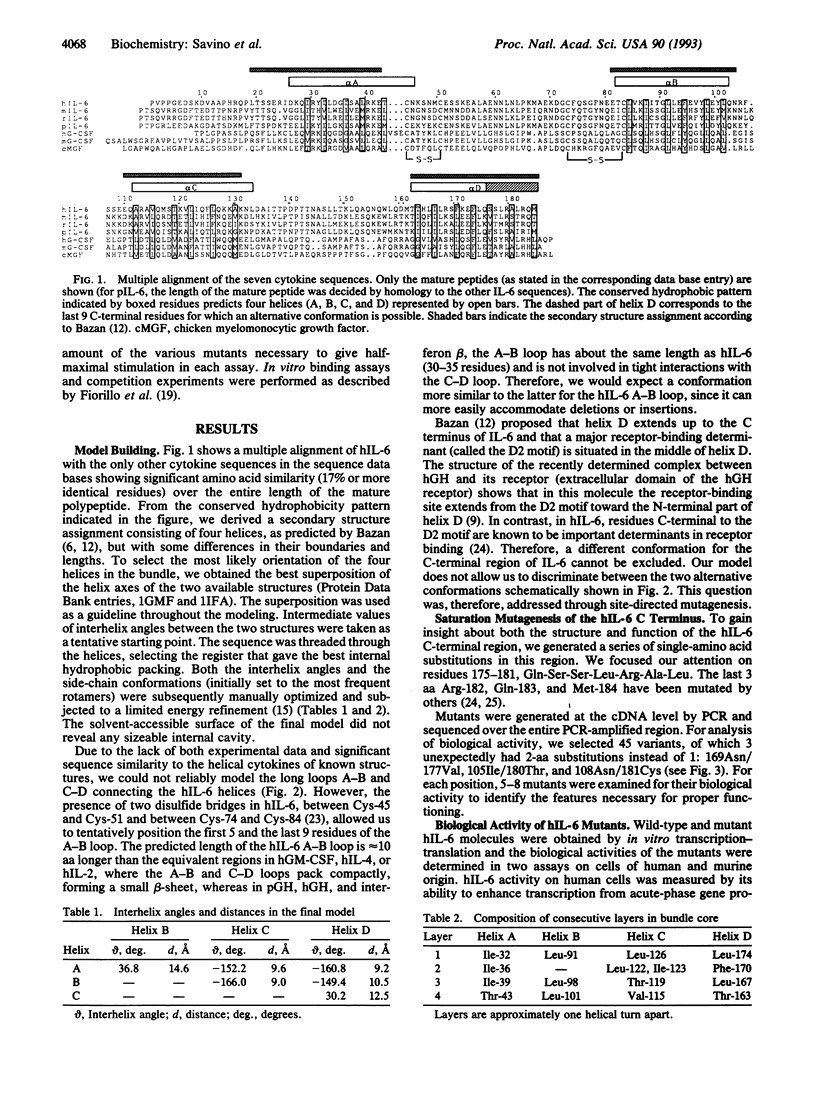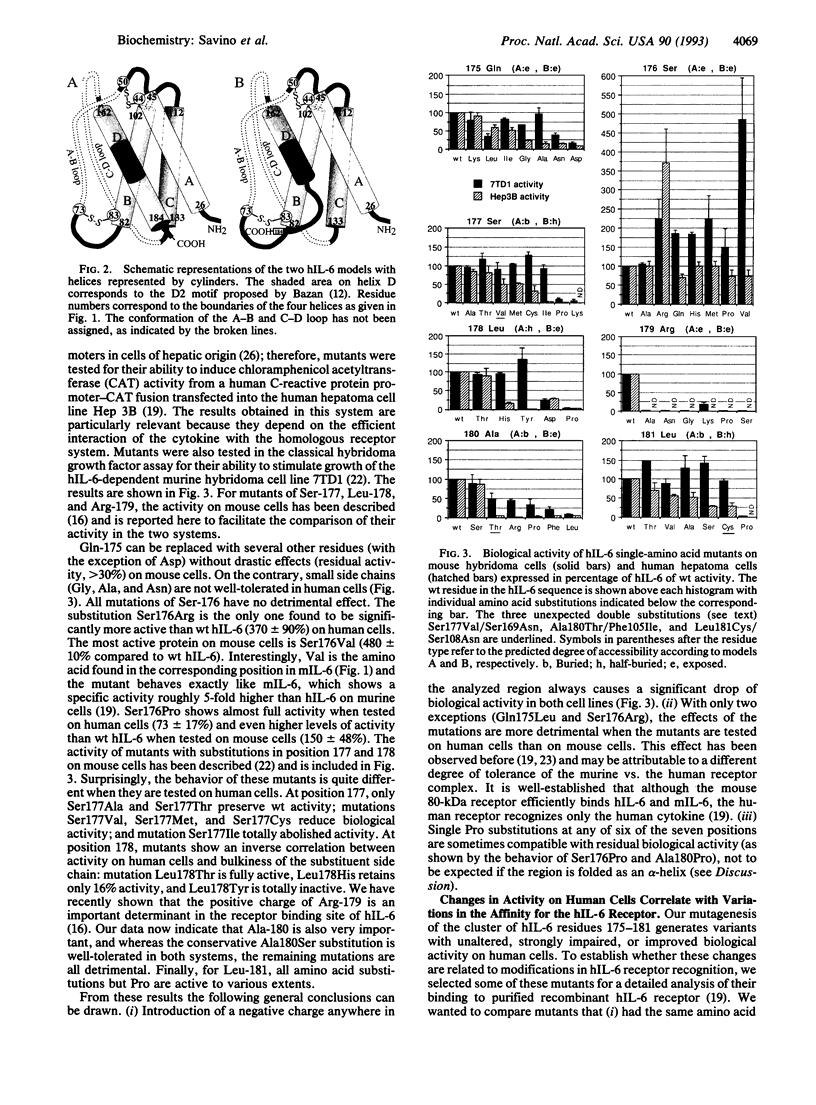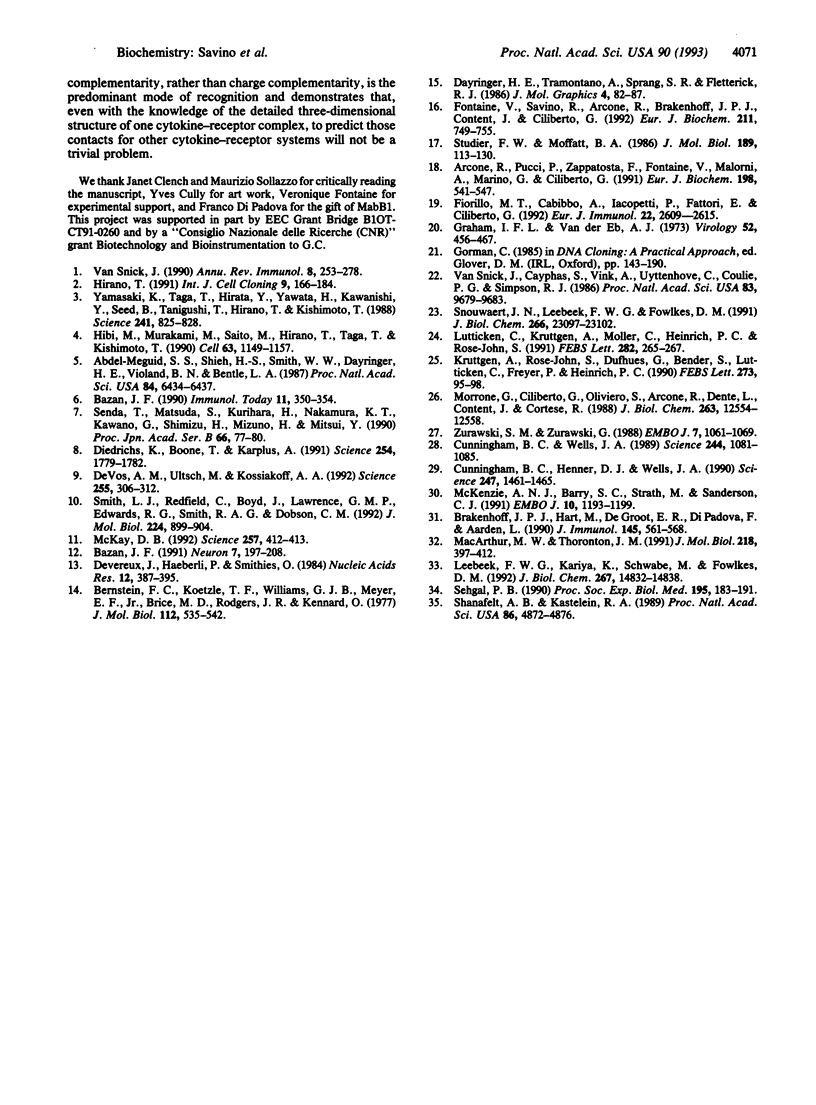Abstract
Interleukin 6 is a 184-aa polypeptide postulated to belong to the class of helical cytokines. We built a three-dimensional model of human interleukin 6 based on the similarity of its hydrophobicity pattern with that of other cytokines and on the x-ray structure of growth hormone, interleukin 2, interleukin 4, interferon beta, and granulocyte-macrophage colony-stimulating factor. The resulting model is a bundle of four alpha-helices and suggests possible alternative conformations for the 9 C-terminal amino acids; in this region, the importance of Arg-182 and Met-184 for biological activity has been demonstrated [Lutticken, C., Kruttgen, A., Moller, C., Heinrich, P.C. & Rose-John, S. (1991) FEBS Lett. 282, 265-267]. Therefore, we generated a large collection of single-amino acid variants in residues 175-181. Analysis of their biological activity in two systems and the receptor binding properties of a subset of the mutants indicates that the entire region is involved in forming the receptor binding surface and supports the hypothesis that this region does not assume an alpha-helical conformation. Remarkably, we also found a mutant with receptor affinity and biological activity much higher than wild type; the potential therapeutical value of this finding is discussed.
Full text
PDF




Images in this article
Selected References
These references are in PubMed. This may not be the complete list of references from this article.
- Abdel-Meguid S. S., Shieh H. S., Smith W. W., Dayringer H. E., Violand B. N., Bentle L. A. Three-dimensional structure of a genetically engineered variant of porcine growth hormone. Proc Natl Acad Sci U S A. 1987 Sep;84(18):6434–6437. doi: 10.1073/pnas.84.18.6434. [DOI] [PMC free article] [PubMed] [Google Scholar]
- Arcone R., Pucci P., Zappacosta F., Fontaine V., Malorni A., Marino G., Ciliberto G. Single-step purification and structural characterization of human interleukin-6 produced in Escherichia coli from a T7 RNA polymerase expression vector. Eur J Biochem. 1991 Jun 15;198(3):541–547. doi: 10.1111/j.1432-1033.1991.tb16048.x. [DOI] [PubMed] [Google Scholar]
- Bazan J. F. Haemopoietic receptors and helical cytokines. Immunol Today. 1990 Oct;11(10):350–354. doi: 10.1016/0167-5699(90)90139-z. [DOI] [PubMed] [Google Scholar]
- Bazan J. F. Neuropoietic cytokines in the hematopoietic fold. Neuron. 1991 Aug;7(2):197–208. doi: 10.1016/0896-6273(91)90258-2. [DOI] [PubMed] [Google Scholar]
- Bernstein F. C., Koetzle T. F., Williams G. J., Meyer E. F., Jr, Brice M. D., Rodgers J. R., Kennard O., Shimanouchi T., Tasumi M. The Protein Data Bank: a computer-based archival file for macromolecular structures. J Mol Biol. 1977 May 25;112(3):535–542. doi: 10.1016/s0022-2836(77)80200-3. [DOI] [PubMed] [Google Scholar]
- Brakenhoff J. P., Hart M., De Groot E. R., Di Padova F., Aarden L. A. Structure-function analysis of human IL-6. Epitope mapping of neutralizing monoclonal antibodies with amino- and carboxyl-terminal deletion mutants. J Immunol. 1990 Jul 15;145(2):561–568. [PubMed] [Google Scholar]
- Cunningham B. C., Henner D. J., Wells J. A. Engineering human prolactin to bind to the human growth hormone receptor. Science. 1990 Mar 23;247(4949 Pt 1):1461–1465. doi: 10.1126/science.247.4949.1461. [DOI] [PubMed] [Google Scholar]
- Cunningham B. C., Wells J. A. High-resolution epitope mapping of hGH-receptor interactions by alanine-scanning mutagenesis. Science. 1989 Jun 2;244(4908):1081–1085. doi: 10.1126/science.2471267. [DOI] [PubMed] [Google Scholar]
- Devereux J., Haeberli P., Smithies O. A comprehensive set of sequence analysis programs for the VAX. Nucleic Acids Res. 1984 Jan 11;12(1 Pt 1):387–395. doi: 10.1093/nar/12.1part1.387. [DOI] [PMC free article] [PubMed] [Google Scholar]
- Diederichs K., Boone T., Karplus P. A. Novel fold and putative receptor binding site of granulocyte-macrophage colony-stimulating factor. Science. 1991 Dec 20;254(5039):1779–1782. doi: 10.1126/science.1837174. [DOI] [PubMed] [Google Scholar]
- Fiorillo M. T., Cabibbo A., Iacopetti P., Fattori E., Ciliberto G. Analysis of human/mouse interleukin-6 hybrid proteins: both amino and carboxy termini of human interleukin-6 are required for in vitro receptor binding. Eur J Immunol. 1992 Oct;22(10):2609–2615. doi: 10.1002/eji.1830221021. [DOI] [PubMed] [Google Scholar]
- Fontaine V., Savino R., Arcone R., de Wit L., Brakenhoff J. P., Content J., Ciliberto G. Involvement of the Arg179 in the active site of human IL-6. Eur J Biochem. 1993 Feb 1;211(3):749–755. doi: 10.1111/j.1432-1033.1993.tb17605.x. [DOI] [PubMed] [Google Scholar]
- Graham F. L., van der Eb A. J. A new technique for the assay of infectivity of human adenovirus 5 DNA. Virology. 1973 Apr;52(2):456–467. doi: 10.1016/0042-6822(73)90341-3. [DOI] [PubMed] [Google Scholar]
- Hibi M., Murakami M., Saito M., Hirano T., Taga T., Kishimoto T. Molecular cloning and expression of an IL-6 signal transducer, gp130. Cell. 1990 Dec 21;63(6):1149–1157. doi: 10.1016/0092-8674(90)90411-7. [DOI] [PubMed] [Google Scholar]
- Hirano T. Interleukin 6 (IL-6) and its receptor: their role in plasma cell neoplasias. Int J Cell Cloning. 1991 May;9(3):166–184. doi: 10.1002/stem.5530090303. [DOI] [PubMed] [Google Scholar]
- Krüttgen A., Rose-John S., Dufhues G., Bender S., Lütticken C., Freyer P., Heinrich P. C. The three carboxy-terminal amino acids of human interleukin-6 are essential for its biological activity. FEBS Lett. 1990 Oct 29;273(1-2):95–98. doi: 10.1016/0014-5793(90)81059-w. [DOI] [PubMed] [Google Scholar]
- Leebeek F. W., Kariya K., Schwabe M., Fowlkes D. M. Identification of a receptor binding site in the carboxyl terminus of human interleukin-6. J Biol Chem. 1992 Jul 25;267(21):14832–14838. [PubMed] [Google Scholar]
- Lütticken C., Krüttgen A., Möller C., Heinrich P. C., Rose-John S. Evidence for the importance of a positive charge and an alpha-helical structure of the C-terminus for biological activity of human IL-6. FEBS Lett. 1991 May 6;282(2):265–267. doi: 10.1016/0014-5793(91)80491-k. [DOI] [PubMed] [Google Scholar]
- MacArthur M. W., Thornton J. M. Influence of proline residues on protein conformation. J Mol Biol. 1991 Mar 20;218(2):397–412. doi: 10.1016/0022-2836(91)90721-h. [DOI] [PubMed] [Google Scholar]
- McKay D. B. Response. Science. 1992 Jul 17;257(5068):412–413. doi: 10.1126/science.257.5068.412. [DOI] [PubMed] [Google Scholar]
- McKenzie A. N., Barry S. C., Strath M., Sanderson C. J. Structure-function analysis of interleukin-5 utilizing mouse/human chimeric molecules. EMBO J. 1991 May;10(5):1193–1199. doi: 10.1002/j.1460-2075.1991.tb08060.x. [DOI] [PMC free article] [PubMed] [Google Scholar]
- Morrone G., Ciliberto G., Oliviero S., Arcone R., Dente L., Content J., Cortese R. Recombinant interleukin 6 regulates the transcriptional activation of a set of human acute phase genes. J Biol Chem. 1988 Sep 5;263(25):12554–12558. [PubMed] [Google Scholar]
- Sehgal P. B. Interleukin 6 in infection and cancer. Proc Soc Exp Biol Med. 1990 Nov;195(2):183–191. doi: 10.3181/00379727-195-43129d. [DOI] [PubMed] [Google Scholar]
- Shanafelt A. B., Kastelein R. A. Identification of critical regions in mouse granulocyte-macrophage colony-stimulating factor by scanning-deletion analysis. Proc Natl Acad Sci U S A. 1989 Jul;86(13):4872–4876. doi: 10.1073/pnas.86.13.4872. [DOI] [PMC free article] [PubMed] [Google Scholar]
- Smith L. J., Redfield C., Boyd J., Lawrence G. M., Edwards R. G., Smith R. A., Dobson C. M. Human interleukin 4. The solution structure of a four-helix bundle protein. J Mol Biol. 1992 Apr 20;224(4):899–904. doi: 10.1016/0022-2836(92)90457-u. [DOI] [PubMed] [Google Scholar]
- Snouwaert J. N., Leebeek F. W., Fowlkes D. M. Role of disulfide bonds in biologic activity of human interleukin-6. J Biol Chem. 1991 Dec 5;266(34):23097–23102. [PubMed] [Google Scholar]
- Studier F. W., Moffatt B. A. Use of bacteriophage T7 RNA polymerase to direct selective high-level expression of cloned genes. J Mol Biol. 1986 May 5;189(1):113–130. doi: 10.1016/0022-2836(86)90385-2. [DOI] [PubMed] [Google Scholar]
- Van Snick J., Cayphas S., Vink A., Uyttenhove C., Coulie P. G., Rubira M. R., Simpson R. J. Purification and NH2-terminal amino acid sequence of a T-cell-derived lymphokine with growth factor activity for B-cell hybridomas. Proc Natl Acad Sci U S A. 1986 Dec;83(24):9679–9683. doi: 10.1073/pnas.83.24.9679. [DOI] [PMC free article] [PubMed] [Google Scholar]
- Van Snick J. Interleukin-6: an overview. Annu Rev Immunol. 1990;8:253–278. doi: 10.1146/annurev.iy.08.040190.001345. [DOI] [PubMed] [Google Scholar]
- Yamasaki K., Taga T., Hirata Y., Yawata H., Kawanishi Y., Seed B., Taniguchi T., Hirano T., Kishimoto T. Cloning and expression of the human interleukin-6 (BSF-2/IFN beta 2) receptor. Science. 1988 Aug 12;241(4867):825–828. doi: 10.1126/science.3136546. [DOI] [PubMed] [Google Scholar]
- Zurawski S. M., Zurawski G. Identification of three critical regions within mouse interleukin 2 by fine structural deletion analysis. EMBO J. 1988 Apr;7(4):1061–1069. doi: 10.1002/j.1460-2075.1988.tb02914.x. [DOI] [PMC free article] [PubMed] [Google Scholar]
- de Vos A. M., Ultsch M., Kossiakoff A. A. Human growth hormone and extracellular domain of its receptor: crystal structure of the complex. Science. 1992 Jan 17;255(5042):306–312. doi: 10.1126/science.1549776. [DOI] [PubMed] [Google Scholar]



